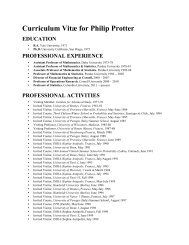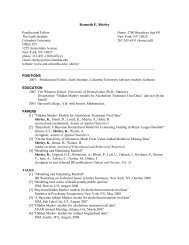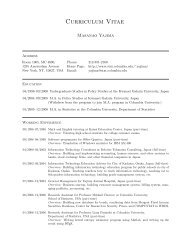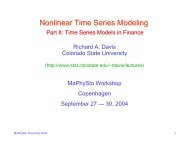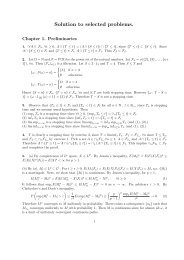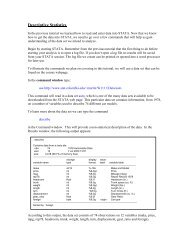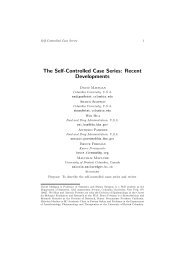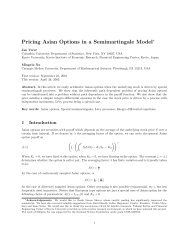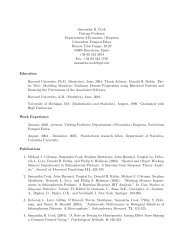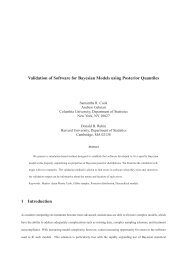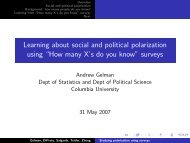sinning in the basement: what are the rules? the ten commandments ...
sinning in the basement: what are the rules? the ten commandments ...
sinning in the basement: what are the rules? the ten commandments ...
You also want an ePaper? Increase the reach of your titles
YUMPU automatically turns print PDFs into web optimized ePapers that Google loves.
APPLIED ECONOMETRICS 579<br />
The issue here is how should <strong>the</strong> model specification be chosen? As usual,<br />
Leamer (1996, p. 189) has an amus<strong>in</strong>g view:<br />
As you wander through <strong>the</strong> thicket of models, you may come to question <strong>the</strong><br />
mean<strong>in</strong>g of <strong>the</strong> Econometric Scripture that presumes <strong>the</strong> model is given to<br />
you at birth by a wise and beneficent Holy Spirit.<br />
In practice, model specifications come from both <strong>the</strong>ory and data, and given<br />
<strong>the</strong> absence of Leamer’s Holy Spirit, properly so. An important <strong>in</strong>gredient <strong>in</strong><br />
specification searches, of<strong>ten</strong> forgot<strong>ten</strong>, is captured by Smith’s (1998) question<br />
‘Why <strong>are</strong> you do<strong>in</strong>g this?’ and spelled out by Magnus (1999, p. 61)<br />
The best we can hope for is that a model is valid locally. This implies that <strong>the</strong><br />
model should depend on <strong>the</strong> central question which <strong>the</strong> researcher wishes<br />
to answer ... Everyth<strong>in</strong>g else — your model, <strong>the</strong> data that you need, your<br />
estimation method — depends on it. Now, this may seem obvious, but it is<br />
not obvious to most econometricians.<br />
If this is not obvious to econometricians, it quickly becomes obvious <strong>the</strong> moment<br />
<strong>the</strong>y undertake applied work, as noted by Feldste<strong>in</strong> (1982, p. 829):<br />
The applied econometrician, like <strong>the</strong> <strong>the</strong>orist, soon discovers from experience<br />
that a useful model is not one that is ‘true’ or ‘realistic’ but one that is<br />
parsimonious, plausible, and <strong>in</strong>formative.<br />
The process by which a specification is developed, blend<strong>in</strong>g economic <strong>the</strong>ory,<br />
common sense, and a judicious mixture of both bottom-up and top-down,<br />
clearly <strong>in</strong>corporates elements of ‘data m<strong>in</strong><strong>in</strong>g’, a term<strong>in</strong>ology with strong<br />
emotive con<strong>ten</strong>t. In prelim<strong>in</strong>ary versions of this paper econometricians<br />
compla<strong>in</strong>ed about this rule, orig<strong>in</strong>ally titled ‘Data M<strong>in</strong>e with C<strong>are</strong>’, more than<br />
any o<strong>the</strong>r. The <strong>in</strong><strong>ten</strong>t of this rule is to admit that data m<strong>in</strong><strong>in</strong>g is here to stay, and<br />
<strong>in</strong> light of that, ensure that practitioners <strong>are</strong> fully aw<strong>are</strong> of its po<strong>ten</strong>tial costs.<br />
This view is not new to <strong>the</strong> economics literature. Backhouse and Morgan (2000,<br />
p. 176) summarize a symposium on data m<strong>in</strong><strong>in</strong>g, published <strong>in</strong> <strong>the</strong> June 2000<br />
issue of <strong>the</strong> Journal of Economic Methodology, by not<strong>in</strong>g that some of <strong>the</strong> papers<br />
<strong>in</strong> this symposium advocate an <strong>in</strong>crease <strong>in</strong> data m<strong>in</strong><strong>in</strong>g but ‘hedge this with<br />
strong warn<strong>in</strong>gs about <strong>the</strong> need for such data m<strong>in</strong><strong>in</strong>g to be undertaken <strong>in</strong> a<br />
suitable manner’.<br />
Rule #8: Be prep<strong>are</strong>d to compromise.<br />
This rule reflects Trosset’s (1998, p. 24) observation that<br />
In virtually every application, <strong>the</strong>re is a gap (of<strong>ten</strong> a vast gulf) between <strong>the</strong><br />
details of <strong>the</strong> application and standard statistical <strong>the</strong>ory ... gaps between<br />
application and <strong>the</strong>ory require that compromise be made.<br />
Leamer (1997, p. 552) lends it special emphasis when list<strong>in</strong>g his choices for <strong>the</strong><br />
three most important aspects of real data analyses: ‘compromise, compromise,<br />
compromise’. Its most eloquent expression <strong>in</strong> <strong>the</strong> econometrics literature,<br />
# Blackwell Publishers Ltd. 2002



